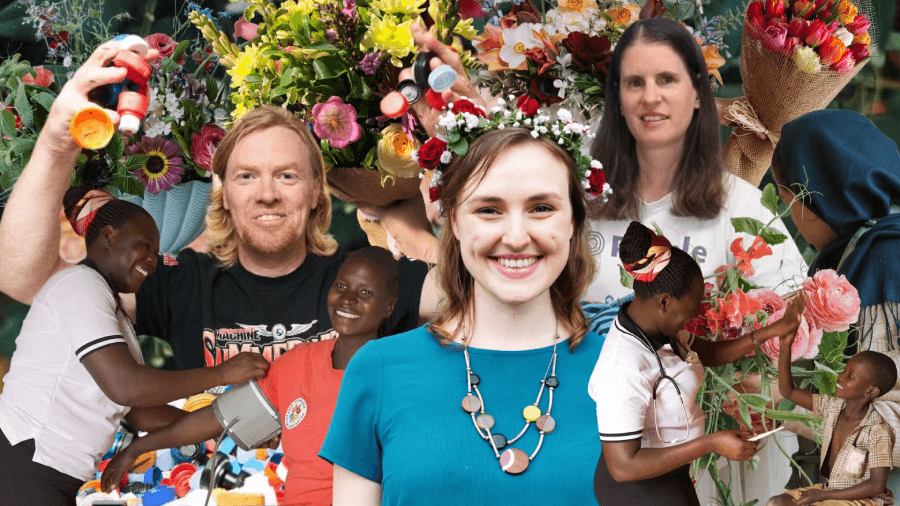Crowdfunding is great!
Obviously I would think that, I founded a crowdfunding platform, but the reason I did so is I believe deeply in the need to invest more in innovation for social change, and in the face of a funding sector traditionally focused on the already-proven, crowdfunding is filling a huge gap for social entrepreneurs and communities to share, test, launch and grow impact initiatives.
Through crowdfunding grassroots leaders and social innovators can share their ideas and invite local – and global – communities to join them in making it happen.
Through crowdfunding individuals can choose the level of risk and quantity of funds that is appropriate and acceptable for them, and we can test the community’s reaction to new products and ideas before we go too far down the track of investing in those ideas. By aggregating those individual contributions, we can create funding rounds sufficient to launch new enterprises, save community organisations, fund civic projects and so much more.
But if crowdfunding is so great, why do the vast majority of crowdfunding campaigns fail?
They mostly fail because of a set of common misunderstanding about how crowdfunding works, which leads to a failure to invest your efforts and energy in the right way to succeed.
These are the five most common misunderstanding we see:
Mistake 1: Not realising crowdfunding is really hard
Most people have no idea what the overall success rate is in crowdfunding, or for any individual platform. Overall, it’s not great. And for some platforms, it’s downright terrible.
Entrepreneur Magazine recently published a feature on this, declaring that “LESS THAN ONE THIRD OF CROWDFUNDING CAMPAIGNS SUCCEED.”
In fact, of the platforms they surveyed, NONE had a success rate as high as one-third. This is shocking for many people, but it shouldn’t be. Fundraising is hard!
There’s a lot of people out there who want the same money you want, and are working hard to get it. Without careful planning and strong execution, it’s hard to convince people to invest in you, or even to get them to notice that you exist.
A big part of this misunderstanding stems from a particular dynamic in crowdfunding where success is loud and failure is very quiet, because what they’ve failed to do is capture any attention, so it’s common to see almost nothing but successful campaigns, even as most are out there falling short.
When you see nothing but success it’s easy to fall into a false sense of security. If everyone is succeeding, how hard could it be? How much hard work or preparation do you need to put in? Why not just throw your idea online, that seems to work?
But that is, in fact, a recipe for almost guaranteed failure. Only careful planning and a solid plan will set you up for success. A bit part of StartSomeGood’s industry-leading success rate is simply that we take the time and effort to ensure people know what they’re up against, and help them develop an outreach plan that can work. We also have the right model to help you succeed (see mistake 5 below).
Mistake 2: Focusing on what’s new, missing what’s the same
Crowdfunding isn’t really new. The practice of aggregating our resources so we can collectively fund things no one of us could individually afford is as old as tithing. But even in the modern sense of time-limited goal-specific fundraising campaigns, this is a venerable tradition.
Let me give you an example.
In 1885, the French gifted the Statue of Liberty to the people of America. Most people know that part of the story, but not what happened next.
It turns out 100-foot tall metal statutes aren’t the easiest gift in the world to receive. It was going to take some serious investment. $250,000 USD to be exact (almost ten million in today’s money), to create the base for her to stand on. That’s a lot of money! So the government didn’t want to pay it, and neither did the traditional philanthropist class.
In desperation Joseph Pulitzer put an add in his newspaper, the News of the World, calling for donations to cover the $100,000 shortfall to allow the statue to be installed. In response 120,000 people contributed, on average, 0.84c each, reaching the required budget.
And this is why Lady Liberty stands in New York Harbour today, because the people of New York made it so through their contributions. They crowdfunded it!
So what happened here? There are three key elements to this campaign, and they are still the key elements you need today: A great story, a distribution mechanism for that story (an ad in the newspaper) and a collection mechanism for the funds (cheques and the postal system).
You still need all of those! You may have a great story, but if you don’t get it out to people and make it easy for them to get the funds back to you, you won’t raise anything.
What’s great about the moment we live is you don’t need to own a newspaper now, and your supporters don’t need envelopes and stamps. Platforms like StartSomeGood give you what you need, but you have to put the work in!
Mistake 3: Expecting it to be automatic
There are some amazing platforms in the world today which take responsibility for generating, and matching, both supply and demand within a given sector. You’re familiar with some of these “two-sided marketplaces”, such as Airbnb and Uber/Lyft/Grab/etc.
If you list your spare bedroom on Airbnb, you probably don’t spend any time wondering where your customers are going to come from – that’s Airbnb’s job. Your job is to create a great listing – write good copy, take some nice photos, set a reasonable price, then respond to the demand that arrives.
And that’s how many people are approaching crowdfunding – thinking their job is the listing, not the outreach which draws attention to the listing.
I’m sorry to say that’s just not how crowdfunding works.
The job of a fundraiser is always to get out there and find your potential funder/investor/customer/donor. Not to wait around for them to find you.
I saw the co-founder of Kickstarter speak some years ago and he made the same point. When asked in the Q&A what was the value of being the hero campaign on the Kickstarter homepage he said “the value is approximately zero. Donors don’t come through the homepage.”
So where do the donors come from? They come via direct links, distributed through twitter, facebook, email, flyers, blog posts, news articles and more. How did they find those links? They didn’t, those links found them, thanks to smart focused outreach from campaign creators.
The key is to not think of the platform as being the source of your supporters, but the tools you are using to share your story and process contributions. Distribution is still your job. In other word, the platforms are not playing the role of the newspaper in the Statue of Liberty example above, they are replacing the cheques and the postal system.
Don’t sit back and expect everyone to just show up to your party, you need to get out there and promote!
Mistake 4: Thinking crowdfunding is about crowds
This is certainly an understandable mistake to make – it’s right there in the name!
When we first launched StartSomeGood we refused the use the word “crowdfunding” anywhere on our site, insisting on calling it by a more accurate and descriptive name, Peerfunding. But that turned out to be terrible for SEO. You have to use the language everyone else understands, so here I am writing a “5 mistakes of crowdfunding” blog post despite hating this name.
It doesn’t really matter what you call it, it matters that you understand how it works.
And crowdfunding isn’t about crowds.
It’s about communities.
Unlike a crowd, an anonymous mass of individuals you don’t really know or understand, a community is knowable, tangible and buildable. You create a community not just by spraying your message and praying it reaches the right people but by considering who shares your passion for the work you’re doing, who is likely to be inspired by the future you’re creating, and how you can best reach those people in a focused way.
You create your community of supporters by caring about who they are, by focusing your efforts to share your stories with those most likely to care, and by telling a story that inspires them to come along on the journey with you.
There is no single story that inspires everyone, so the core challenge of crowdfunding is a targeting challenge: telling your story to the right people who are most likely to support you. Like any marketing campaign, it starts by knowing who you are trying to market to, or rather, what is the community you are trying to build.
Mistake 5: Not understanding the tools, not choosing the right model
Because too many people think of crowdfunding platforms as the location of their supporters, rather than the tools they are using to find and aggregate those supporters, they fail to understand the choice of tool-set provided by crowdfunding and will tend to gravitate to the bigger platforms on the mistaken assumption that that gives them a chance to be seen by more people (not true, as the founder of Kickstarter himself has pointed out).
These days you have choices of equity, debt, donation and pre-sale crowdfunding, but just to take this later category, pre-sale/donation, which is offered by most of the world’s significant platforms including Kickstarter, IndieGoGo, GoFundMe, Pozible, Crowdfunder and of course StartSomeGood, there are two very different models with very different implications for how your campaign will run, and the results you will likely achieve.
Those two models are:
Keep-What-You-Raise, also called Flexible Funding, and
All-Or-Nothing, also called Fixed Funding, or on StartSomeGood, the Tipping Point.
I’m always surprised how little time people put into choosing the right model for them and their campaign. It’s a bit like deciding you want to be a retailer but then flipping a coin to decide whether to launch a bricks-and-mortar shop or a website. These are both retailing, but have very different implications for how you would go about it, and it’s the same with your choice of crowdfunding model.
What’s most important when choosing a model is not to focus on what you like the sound of more, but rather on what your potential supporters are going to prefer. In the social sector, you see a lot of projects choosing Keep-What-You-Raise, because they are thinking of it as a choice of keeping or not keeping what they raise, and what sort of choice is that? Of course you want to keep what you have raised. But it’s not about what you want. It’s about what your potential supporters want.
The problem with Keep-What-You-Raise is that for most projects, especially those which are newer and more innovative, this model makes it much harder to raise funds in the first place. So you’ll get to keep it, but you’ll struggle to make much progress.
Percentage of campaigns ended fully funded

There’s a reason that of the 6 platforms in the graph above the 3 with success rates of below 20% are all Keep-What-You-Raise platforms and the three with success rates above 25% are All-or-Nothing platforms, including StartSomeGood with our industry-leading 53% rate.
This isn’t a coincidence. If you expended this graph to include the hundreds of crowdfunding platforms in the world they would be almost perfectly sorted, with even the worst All-or-Nothing platform outperforming the best Keep-What-You-Raise platform.
Why is this?
The key challenge of fundraising is to overcome people’s sense of risk, especially when supporting newer and more innovative campaigns, or emerging entrepreneurs who are not well-known. And the fact is, knowing that you are keeping my money no-matter what, even if you can’t follow through from lack of budget, feels very risky to me and to most people. It may feel less risky for you, but the honest truth is nobody besides your family and close friends care about what feels more or less risky for you. It’s your job to care about what feels more or less risky to your potential supporters.
Telling people you’re going to keep their money even if you can’t follow-through is pretty bad for building credibility whereas promising that you will only take my funds if you have achieved the funding you require to follow-through makes it so much easier to take that leap of faith with you.
This is why Keep-What-You-Raise is such a bad model for most social enterprises. Unlike a charitable project which can create some impact with some funding, most social enterprises need a specific amount of investment to go forwards, whether this is to buy the truck for your food truck, kit out the café or manufacture and ship the product.
The good news is however that these are all easy mistakes to correct.
We have achieved the best project success rate in crowdfunding at StartSomeGood simply by making the extra effort to ensure aspiring crowdfunders know what they are up to and helping them bring their campaigns up to the standard required.
If you are working on a social enterprise, or an impact project of any kind, we would love to help you succeed too!



